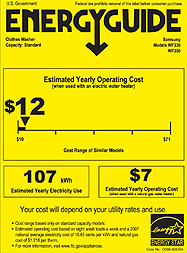
Appliance Tips
 When purchasing new appliances, you're faced with a number of difficult decisions. Which brand is best? How much energy will the appliance use? Will purchasing a higher priced model that provides better efficiency save money in the long run?
When purchasing new appliances, you're faced with a number of difficult decisions. Which brand is best? How much energy will the appliance use? Will purchasing a higher priced model that provides better efficiency save money in the long run? The federal government requires that appliance manufacturers attach Energy Guide labels (image to the left) to all new furnaces, room air conditioners, water heaters, dishwashers, refrigerators, freezers, and clothes dryers. They provide information about yearly energy costs and how the particular model compares to others.
The following information is detailed on the labels:
- National average unit cost of fuel
- Estimated annual cost for operating this appliance using the national average unit cost of fuel
- Range of appliances used in ratings
- A graph showing how this appliance compares to other similar models
- A chart showing the different estimated operating costs for this model at different fuel costs
Compare Costs
Knowing how to use the Energy Guide labels will be useful in comparing operating costs between models. You can also compare "lifecycle costs" of appliances by combining the purchase price of an appliance with the energy cost of operating it over its average lifetime.
For example, say you purchase a refrigerator for $800. The Energy Guide yearly cost is $75, and the refrigerator is expected to last 17 years:
$800 + ($75 x 17 years) = $2,075
The lifecycle cost of your new refrigerator would be $2,075.
When comparing appliances with identical features, a good way to determine which is a better buy is to compare lifecycle costs. While you may pay more initially for the energy-efficient model, it will usually pay back in savings on your utility bills several times during the appliance's lifetime.
Helpful Tools & Resources
courtesy of Energy Star
courtesy of Energy Star
- Guide to Energy Efficient Heating & Cooling
English (708KB)
(708KB)
Español (2.5MB)
(2.5MB) - Tips for Hiring a Heating and Cooling Contractor
- Duct Sealing brochure
 (1.13MB)
(1.13MB) - Maintenance Checklist

Cool Your World with ENERGY STAR @ home

Use the Home Energy Yardstick to
Measure Your Home's Performance

